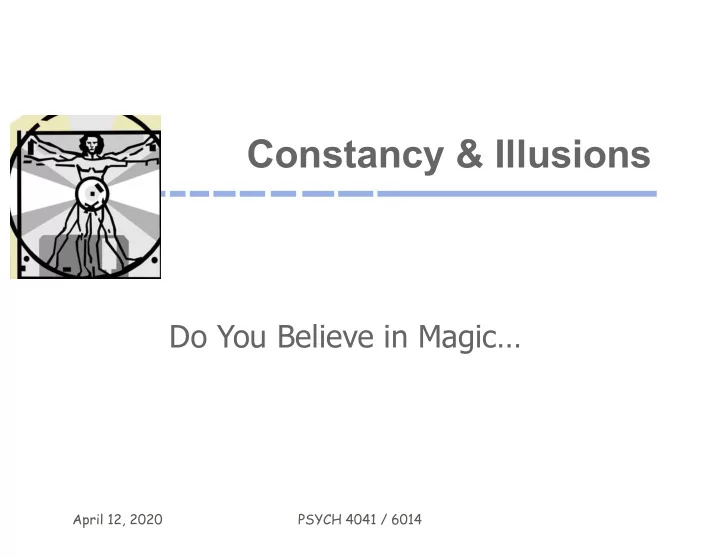

Constancy & Illusions Do You Believe in Magic… April 12, 2020 PSYCH 4041 / 6014
Overview Ø Constancy Ø Illusions Ø Upcoming April 12, 2020 PSYCH 4041 / 6014
Constancy Ø Intro v Despite great variations, we perceive the world as largely constant v Heuristics help us simplify our world v Constancies are the result of several of these heuristics v Illusions are often consistencies (or heuristics) gone wrong April 12, 2020 PSYCH 4041 / 6014
Constancy Ø Lightness Constancy v Lightness of an object appears constant, even in changing lighting • e.g. snow in daylight, snow in shadows, still white • e.g. coal in the sunshine is still black v Albedo • Proportion of reflected light remains constant 90% 10% Context is key!! April 12, 2020 PSYCH 4041 / 6014
Constancy, cont’d Ø Size Constancy v Objects of a known size tend to be perceived as unchanged in size when they change distance • e.g. people seen from 5 story building • Note: “within limits” v Emmert’s Law Size (perceived) = Size (retinal) x Distance (perceived) v Limits of size constancy • Great distances do not support constancy • Not surprising April 12, 2020 PSYCH 4041 / 6014
Constancy, cont’d Ø Shape Constancy v Object is seen to have the same shape, despite different retinal shapes • Other cues provide context (doors, windows, etc.) v We tend to see objects and assume depth April 12, 2020 PSYCH 4041 / 6014
Constancy, cont’d Ø Summary of Constancy v Constancy enables perceptual world to correspond to physical world v Helps us survive v Under some conditions, these (beneficial) heuristics break down v Result is illusions April 12, 2020 PSYCH 4041 / 6014
Illusions Ø Visual illusions are often the result of heuristic perceptual processes trying to deal with rare, ambiguous, or contrived stimuli Ø Countless illusions (will see just a few) Ø Note that experience is often partly to blame for illusory perception v “garden path” April 12, 2020 PSYCH 4041 / 6014
Ames Illusions Ø Trapezoidal window v Assumed rectangularity v Actual trapezoidal shape v Assume regular object that is rotated, rather than irregular object v Demo: https://www.youtube.com/watch?v=cVepIZLepVc April 12, 2020 PSYCH 4041 / 6014
Ames Illusions, cont’d Ø Ames room v Assume rectilinear room--actually very unusual! April 12, 2020 PSYCH 4041 / 6014
Ames Illusions, cont’d Ø Ames room April 12, 2020 PSYCH 4041 / 6014
Moon Illusion Ø Moon near horizon appears larger Ø Possible explanations v Angle of regard • Eye position relative to body • Not supported by physiology v Apparent distance • Since perc’d size is proportional to perc’d distance, then if perc’d distance were greater for the horizon moon it would seem larger • But… distance paradox v Others • e.g. “relative size hypothesis” April 12, 2020 PSYCH 4041 / 6014
Muller-Lyer Illusion Ø Lines of equal length appear different, depending on arrow-head context v Spatial cues “force” depth interpretation (?) April 12, 2020 PSYCH 4041 / 6014
Muller-Lyer Illusion April 12, 2020 PSYCH 4041 / 6014
Ponzo Illusion Ø Perspective (depth) cues dominate and cause errors in size judgments April 12, 2020 PSYCH 4041 / 6014
Poggendorff Illusion Ø Colinear line segments appear misaligned v Perhaps due to assumption about depth of objects v Perspective constancy could explain some examples of this illusion (but not all) April 12, 2020 PSYCH 4041 / 6014
Poggendorff Illusion Ø Context can make it worse (or better) April 12, 2020 PSYCH 4041 / 6014
Contrast Illusions Ø Surrounding objects (context) affects our judgment of size, alignment, color, etc. April 12, 2020 PSYCH 4041 / 6014
Contrast Illusions Ø A variety of examples April 12, 2020 PSYCH 4041 / 6014
Contrast Illusions April 12, 2020 PSYCH 4041 / 6014
Reversible & Multistable Images Ø Some shapes can be seen in multiple orientations v Flips may be result of fatigue April 12, 2020 PSYCH 4041 / 6014
Factors in Illusory Perception Ø Optical and retinal factors v e.g. subjective curvature Ø Cognitive components v e.g. learning, experience, expectation April 12, 2020 PSYCH 4041 / 6014
Impossible Figures Ø Curious…but not really illusory v We accept them when examined locally, but global inconsistencies are confusing April 12, 2020 PSYCH 4041 / 6014
Impossible Figures Ø Escher is master of impossible figures v www.mcescher.com April 12, 2020 PSYCH 4041 / 6014
Escher Demo Videos Ø YouTube: https://www.youtube.com/watch?v=7dMjhhpCQFo https://www.youtube.com/watch?v=f555rLJnDCI https://www.youtube.com/watch?v=JdgPvripL9A April 12, 2020 PSYCH 4041 / 6014
Summary of Illusions Ø No satisfactory single explanation, in general Ø Constancy (of various types) and learning, expectation, and experience are all major contributors to illusory perceptions at times April 12, 2020 PSYCH 4041 / 6014
Upcoming Ø Camouflage April 12, 2020 PSYCH 4041 / 6014
Recommend
More recommend